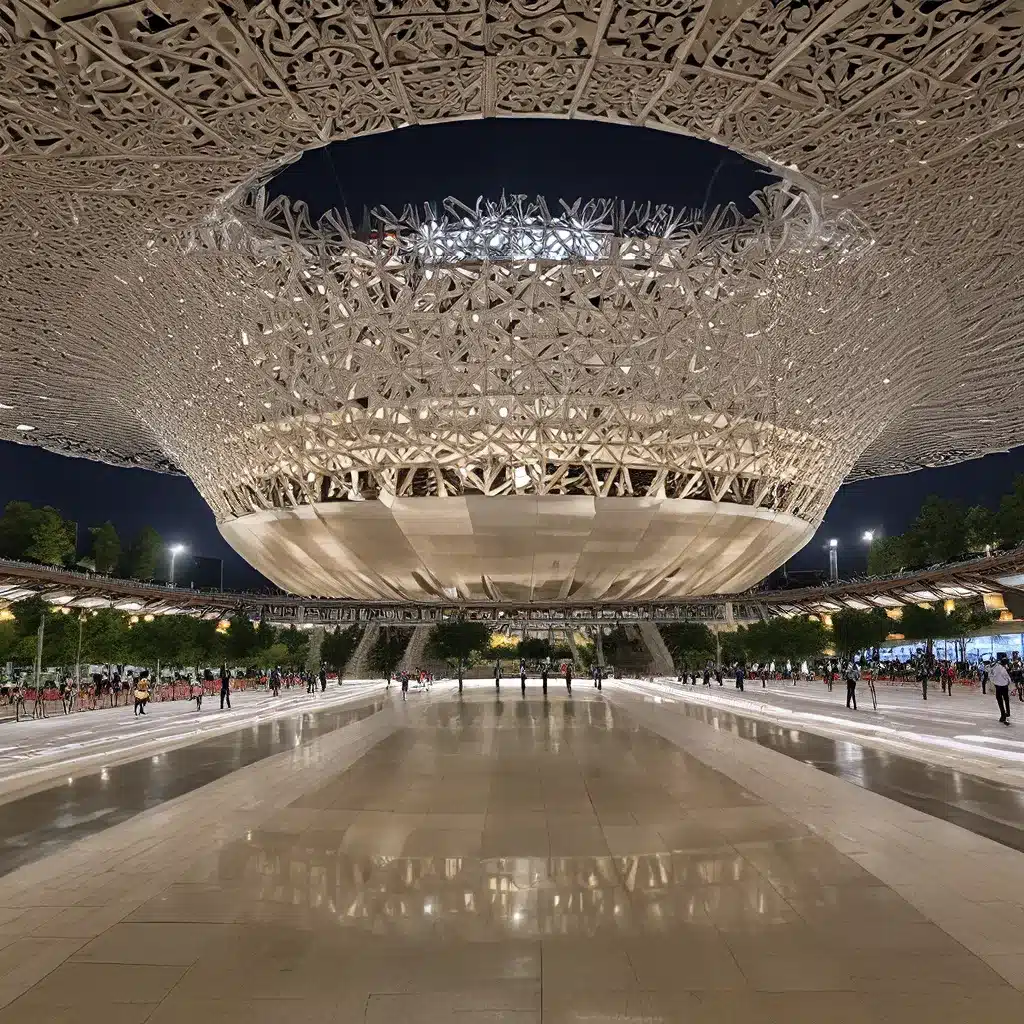
The Architectural Majesty of National Olympic Stadium
The National Olympic Stadium in Tokyo, Japan stands as a testament to the country’s rich cultural heritage and its unwavering commitment to hosting exceptional sporting events. Commissioned for the 1964 Summer Olympics, this iconic structure has captivated visitors from around the world with its awe-inspiring architectural design, steeped in Japanese tradition.
At the heart of the National Olympic Stadium lies a harmonious blend of modern engineering and centuries-old aesthetic sensibilities. The stadium’s striking pagoda-inspired roofline immediately commands attention, evoking the timeless elegance of Japanese temple architecture. This unique design element not only contributes to the stadium’s visual appeal but also serves a practical purpose, providing shade and shelter for the thousands of spectators who fill the stands during major events.
The stadium’s façade is adorned with intricate geometric patterns and ornamental motifs, reflecting the Japanese penchant for attention to detail and artistic expression. These design elements seamlessly integrate the structure into the surrounding landscape, creating a sense of cohesion and a visual feast for the eyes.
Seating Capacity and Facilities
The National Olympic Stadium boasts a seating capacity of 68,000, making it one of the largest sporting venues in Japan. This impressive scale allows the stadium to host a wide range of events, from international sporting competitions to cultural festivals and concerts.
In addition to its impressive seating capacity, the stadium offers a comprehensive suite of facilities to cater to the needs of athletes, officials, and spectators alike. These include:
- Locker rooms and training facilities: Equipped with state-of-the-art amenities, these areas provide a comfortable and well-equipped environment for athletes to prepare for their events.
- Media and broadcast centers: Spacious and technologically advanced, these facilities enable seamless media coverage and live broadcasting of the events taking place within the stadium.
- Hospitality and VIP areas: Offering luxurious accommodations and exclusive services, these areas ensure that distinguished guests and VIPs have a truly exceptional experience during their visits.
Hosting World-Class Events
The National Olympic Stadium has a long and illustrious history of hosting some of the world’s most prestigious sporting events. Its crowning achievement was undoubtedly the 1964 Summer Olympics, which marked Japan’s triumphant return to the global stage following the devastation of World War II.
The stadium’s subsequent role in the 2020 Summer Olympics, albeit delayed by the COVID-19 pandemic, further cemented its status as a world-class venue capable of delivering unforgettable experiences for athletes and spectators alike. During these games, the stadium played host to a wide range of competitions, including athletics, football, and the opening and closing ceremonies.
Beyond the Olympic Games, the National Olympic Stadium has also been the stage for numerous international football matches, stadium tours, and cultural events that have captivated audiences worldwide. Its versatility and adaptability have made it an indispensable part of Japan’s sporting and cultural landscape.
Architectural Innovation and Sustainability
The National Olympic Stadium is not only a visual masterpiece but also a testament to architectural innovation and sustainability. The stadium’s design incorporates a range of energy-efficient and environmentally-friendly features, including:
- Retractable roof: The stadium’s retractable roof system allows for seamless adaptation to changing weather conditions, ensuring the comfort and safety of spectators and athletes.
- Renewable energy sources: The stadium utilizes solar panels and other renewable energy sources to power its operations, reducing its carbon footprint and promoting sustainable practices.
- Waste management: The stadium has implemented robust waste management systems, including recycling and composting initiatives, to minimize its environmental impact.
These innovative design elements not only enhance the stadium’s functionality but also demonstrate Japan’s commitment to creating sustainable and eco-conscious sporting infrastructure.
Ongoing Renovations and Upgrades
The National Olympic Stadium is not a static structure but rather an ever-evolving one, undergoing continuous renovations and upgrades to ensure its relevance and competitiveness in the global sporting landscape.
Recent years have seen the implementation of a comprehensive modernization plan, which has included the installation of state-of-the-art audio-visual systems, the expansion of hospitality and VIP facilities, and the enhancement of accessibility features to cater to the needs of all visitors.
These ongoing improvements reinforce the stadium’s position as a world-class venue, capable of hosting the most prestigious events while also providing an exceptional experience for both athletes and spectators.
Preserving Cultural Heritage
Amidst the constant evolution and modernization, the National Olympic Stadium remains committed to preserving its cultural heritage and Japanese identity. The stadium’s architectural design, with its iconic pagoda-inspired roof and intricate geometric patterns, serves as a tangible link to the country’s rich cultural legacy.
Moreover, the stadium’s role in hosting major cultural events, such as traditional Japanese festivals and performances, further solidifies its position as a custodian of national pride and identity. By seamlessly blending the old and the new, the National Olympic Stadium has become a symbol of Japan’s ability to honor its past while embracing the future.
Conclusion
The National Olympic Stadium in Tokyo, Japan, is a truly remarkable and multifaceted venue that embodies the country’s rich cultural heritage, architectural prowess, and commitment to hosting world-class sporting and cultural events. From its pagoda-inspired design to its state-of-the-art facilities and sustainable features, the stadium stands as a testament to Japan’s ability to blend tradition and innovation in a harmonious and captivating manner.
As the world continues to marvel at the stadium’s architectural wonders and its ability to host prestigious events, the National Olympic Stadium remains a symbol of Japan’s enduring spirit and its unwavering dedication to excellence. Whether you’re a sports enthusiast, a cultural aficionado, or simply someone in awe of exceptional architectural achievements, a visit to this remarkable venue is sure to leave a lasting impression.

